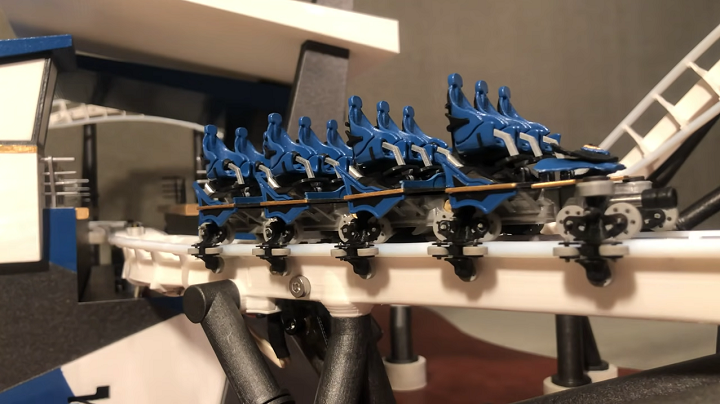If it ever comes up in conversation, I will freely admit that I am a total roller coaster junkie. I love them—the higher and crazier, the better. Give me inversions, backward riding, and magnetic propulsion starts any day of the week! So I really enjoy this story about a 3D printed roller coaster that took Dan Fritsche, a designer and 2019 mechanical engineering graduate of Iowa State University, over 900 hours to create. Fritsche, known on Instagram and YouTube as @3d_coasters, took it upon himself to design, 3D print, and build an original model of a self-launching roller coaster, which he calls simply “Launch.” At a 1:35 scale, it’s definitely bigger than this 1:60 scale model roller coaster, and it actually works.
In an interview with Coaster 101, Fritsche talks about his 3D printed masterpiece, and how his longtime love of roller coasters inspired him to create it.
“In 2018, I had the opportunity of a lifetime to intern at Premier Rides for 7 months. Learning the ins and outs of coaster design, I gained a whole new appreciation for these awesome machines after seeing firsthand how they were built. Going forward, I’d love to get the chance to work at a coaster manufacturer again and will continue to do whatever I can to chase the dream. But for now, designing and printing them myself is good enough until another opportunity comes along,” he said.
The amount of detail in the 3D printed roller coaster is breathtaking, and it took hundreds of hours just to design the track layout and coaster using NoLimits2 roller coaster simulation and Fusion 360, then preparing the design in Cura, before he had to worry about assembling the 2,983 individual parts.
“Once I designed and settled on a layout in NoLimits2 (NL2), I exported the spline coordinates and imported them into Fusion 360 where I hand modeled everything from there. This was all relatively straightforward, but extremely time consuming — around 600 hours for the train, track, columns, station, launch, brake run, etc.,” Fritsche explained.
It took over 800 hours of 3D printing, and seven rolls of filament, to print out all of the parts, which then had to be sanded and finished by hand. This was especially important for the track pieces, as they had to be smooth enough to reduce any unwanted friction. After the 35 hours spent sanding and finishing the 3D printed parts, Fritsche spent 20 hours assembling the miniature coaster, which features an operator booth and eight seats; then, another 10 hours were spent troubleshooting the track to make sure that the coaster was able to complete a circuit after launch.
This coaster model features a modern design, in which electronic launching systems are used to accelerate the ride vehicle instantly—very different from the more traditional roller coasters that start with a slow ride up a tall hill and then go into a steep drop to give the coaster its needed energy. Fritsche said the most challenging part of the whole project was the coding:
“The last thing was to automate it all, so I put micro servo motors in wherever motion was needed. Then, with the help of one of my friends, wrote a simple code to run the launch mechanism, brakes, station gates, and drive tires.”
In terms of hardware, he printed those thousands of parts on a Creality CR-10, relying on a plotter and electric drill for printing and drilling the footer locations, respectively. A skill saw was used for cutting the shape of the base, while he finished the base edges with a router.
“The launch, brakes, and station are all controlled via an Arduino with 5 micro servo motors and 1 DC motor,” Fritsche said in the YouTube video description. “This proof of concept taught me invaluable lessons in design feasibility, problem solving, and most importantly perseverance. This project was not easy, but it’s impossible to say how much fun I had with it! I’ve already begun working on the next one where I hope to increase the realism, ride length, difficulty, and of course the inversion count.”
Trust me when I tell you to check out the roughly five-minute video of the coaster in action, it’s pretty cool. It’s also making me want to get in line for a roller coaster ASAP!
Subscribe to Our Email Newsletter
Stay up-to-date on all the latest news from the 3D printing industry and receive information and offers from third party vendors.
Print Services
Upload your 3D Models and get them printed quickly and efficiently.
You May Also Like
Making Space: Stratasys Global Director of Aerospace & Defense Conrad Smith Discusses the Space Supply Chain Council
Of all the many verticals that have been significant additive manufacturing (AM) adopters, few have been more deeply influenced by the incorporation of AM into their workflows than the space...
EOS in India: AM’s Rising Star
EOS is doubling down on India. With a growing base of aerospace startups, new government policies, and a massive engineering workforce, India is quickly becoming one of the most important...
PostProcess CEO on Why the “Dirty Little Secret” of 3D Printing Can’t Be Ignored Anymore
If you’ve ever peeked behind the scenes of a 3D printing lab, you might have caught a glimpse of the post-processing room; maybe it’s messy, maybe hidden behind a mysterious...
Stratasys & Automation Intelligence Open North American Tooling Center in Flint
Stratasys has opened the North American Stratasys Tooling Center (NASTC) in Flint, Michigan, together with automation integrator and software firm Automation Intelligence. Stratasys wants the new center to help reduce...






































